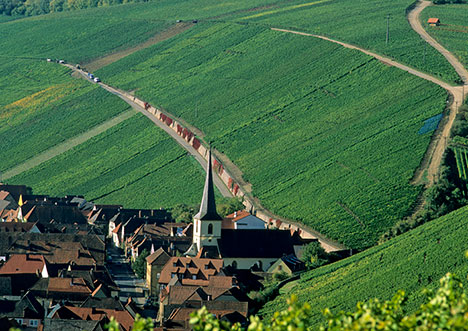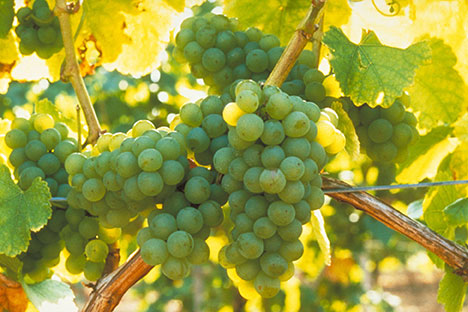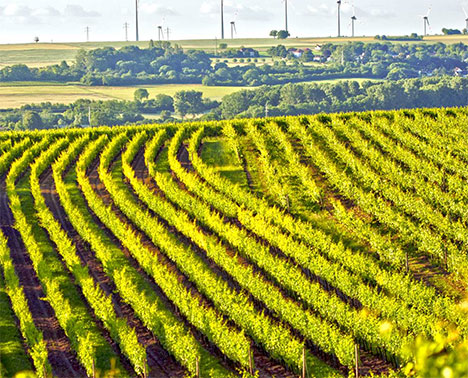The green Silvaner - its full name in Germany - is one of the oldest cultivated vines in Europe. According to its records, the grape variety, originally from Austria, was first planted in Franconia in 1665 by the Ebrach Cistercian abbot Alberich Degen. For a long time, Silvaner was considered the noblest variety in the land and until the early 1990s it was also dominant in terms of area.
Since then, it has not only lost ground in terms of area, but also in terms of reputation. The main reason for this is probably the triumph of Riesling and with it the trend towards more aromatic wines with as much fruit as possible. Silvaner can only offer both to a limited extent. Although the wines often have more or less fine pear and apple aromas, especially when they are young, they are dominated early on by more vegetal aromas, often reminiscent of root vegetables, which usually completely replace the fruity tones once the wine has matured a little in the bottle. Silvaner never really has the lively citrus or even stone fruit aromas of a Riesling - and if it does, one can usually assume that its aromatic development has been deliberately interfered with in the cellar.
Over time, artichokes or white cabbage are often added. Pepper and caraway are also regularly found in the aromatic spectrum of high-class ripe Silvaner. Like few other varieties, Silvaner also clearly reflects its origin in its aroma. Here, it is usually superior even to the much more aromatic Riesling. This mixture of mostly tart vegetal aromas as well as earthy to mineral and spicy tones makes the variety one of the best and most versatile food companions of all. Depending on its character, origin and maturity, it can be used with hearty rural dishes as well as modern high cuisine.
 |
| View of the wine village Escherndorf (Photo: DWI) |
Although the variety is considered rather neutral, its stylistic and aromatic range is relatively wide. Even as a slender, finely fruity wine for drinking, Silvaner can give great pleasure. In the hands of good producers, even lighter examples with alcohol levels of around 12% often possess astonishing class. Rheinhessen in particular has recently distinguished itself with extremely elegant, delicate and animating varieties, while the Franconians tend to be somewhat more tart and earthy even in this weight category. The latter have also gained considerably in reliability and polish in recent years, without giving away their identity.
Many of the best Silvaners, however, are even more powerful. Silvaner feels quite at home at alcohol levels above 13% and up to 14%, although the results can vary greatly. In Franconia in particular, one still encounters almost everywhere a powerful, broad-shouldered and at the same time pithy to rustic type, which many wine lovers today find a little too heavy and too strenuous. Nevertheless, these wines can be surprisingly deep and complex and, especially after a few years of ageing, worthy of any attention. Alcohol levels above 14% are becoming rarer and rarer, however, and even in the powerful category, wines have now gained decidedly in finesse almost everywhere.
It is obvious that more and more producers are becoming aware of the qualities of Silvaner again. Although the top quality is still dominated by well-known names with a clear Franconian predominance, more and more new names have been added recently at an astonishing speed. Rheinhessen in particular, which for years remained in second and third place despite various efforts to raise the profile and quality of Silvaner, is currently developing an astonishing dynamic, but more and more remarkable wines are also being produced in the Palatinate, Baden and Württemberg.
 |
| Silvan grape in a Franconian vineyard (Photo: DWI) |
And Franconians are also on the move. In addition to the well-known top producers, more and more names are emerging that were either completely unknown until now, such as Weinmanufaktur 3 Zeilen, which came out on top of the 2013 vintage, or have been working their way up steadily for years. In Franconia, these are above all May from Retzstadt, Roth from Wiesenbronn, Bickel-Stumpf from Frickenhausen and Brennfleck from Sulzfeld, where Luckert's success seems to be contagious, but Schwane in Volkach is also convincing time and again with mighty, but nevertheless very well-made Grossen Gewächs.
In Rheinhessen, one can hardly list all the producers one should keep an eye on. In any case, Kai Schätzel, who focuses on lean, yet expressive and mineral wines on the Rhine front, Gutzler, whose vines are indeed ancient, Riffel, Dreissigacker, whose wines are usually quite opulent, but are also becoming increasingly fine and complex, Steitz, Bettenheimer and Thörle are important. Outside the two classic Silvaner strongholds, the wineries Heid from Württemberg and Odinstal from the Palatinate stand out with remarkable qualities.
 |
| View of single vineyard "Hölle" (picture/copyright: Weingut Thörle) |
But as fast as the development of Silvaner in Germany is progressing, this is only a snapshot. Many readers will probably immediately think of other wineries with strikingly good Silvaner wines that I have forgotten here or whose wines I may not even know yet. We will be on the lookout for them.
The best Silvaners of the 2013 vintage